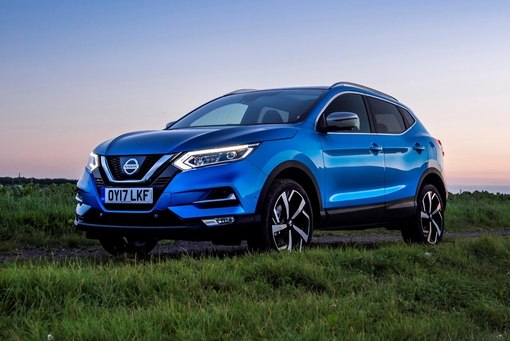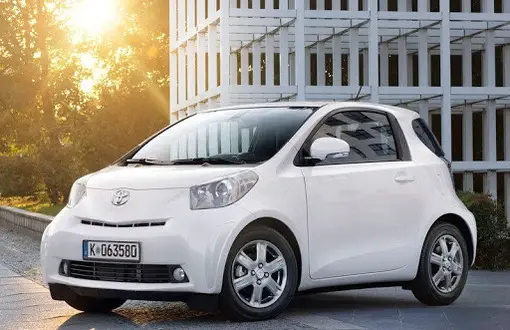4
Hva er Nissan Qashqai eller Toyota iQ?
Nissan Qashqai
Toyota iQ


15 grunner for å kjøpe Nissan Qashqai
-
Stempelslag lenger
7% eller 6.5 mm The longer the piston stroke, the better the engine’s fuel combustion efficiency. This reduces fuel consumption and creates a more environmentally-friendly engine.
87 mm Stempelslag 80.5 mm Stempelslag -
Mer sylinderboring
9% eller 7.5 mm The larger the cylinder bore, the better the combustion chamber fills. This provides power but can also increase engine emissions.
80 mm sylinderboring 72.5 mm sylinderboring -
Mer motorkraft
35% eller 52 hk The greater the vehicle's power, the better the acceleration. Also, powerful cars provide higher speeds.
150 hk motorkraft 98 hk motorkraft -
Mer dreiemoment
64% eller 217 Nm. The higher the torque, the faster the acceleration.
340 Nm @ 1750 rot/min. dreiemoment 123 Nm @ 4400 rot/min. dreiemoment -
Mer toppfart
22 km/h The higher the top speed, the faster the car travels on the highway.
192 km/h toppfart 170 km/h toppfart -
Mer motor kapasitet
24% eller 420 cm3 mer. The greater the engine capacity, the lower the wear and tear. Larger engine capacities provide longer vehicle lifespans.
1749 cm3 motor kapasitet 1329 cm3 motor kapasitet -
Raskere akselerasjon fra 0 til 100 kmt
22% eller 2.1 sek The faster the acceleration, the faster the driver can reach optimal speed, though this can contribute to greater fuel consumption.
9.5 sek akselerasjon fra 0 til 100 kmt 11.6 sek akselerasjon fra 0 til 100 kmt -
Mindre drivstofforbruk (kombinert syklus)
10% eller 0.5 l/100 The lower the fuel consumption, the lower the exhaust emitted into the air. Economical cars are also more efficient to drive.
4.7-4.8 l/100 km drivstofforbruk (kombinert syklus) 5.2 l/100 km drivstofforbruk (kombinert syklus) -
Mindre drivstofforbruk (motorvei)
7% eller 0.3 l/100 The lower the fuel consumption, the lower the pollution-causing emissions. Also, drivers save money by using an economical car.
4.2-4.3 l/100 km drivstofforbruk (motorvei) 4.5 l/100 km drivstofforbruk (motorvei) -
Mindre drivstofforbruk (byen)
17% eller 1.1 l/100 The lower the fuel consumption, the more economical it is to drive the vehicle. Also, economical cars are more environmentally-friendly.
5.3-5.7 l/100 km drivstofforbruk (byen) 6.4 l/100 km drivstofforbruk (byen) -
Mer drivstofftankens kapasitet
42% eller 23 l The greater the fuel tank capacity, the further the vehicle can travel without refueling.
55 l drivstofftankens kapasitet 32 l drivstofftankens kapasitet -
Ovenfor europeisk utslippsstandard
1 generasjon The higher the environmental standards of the vehicle, the less CO2 and other emissions it produces when driving, which reduces harmful effects on the environment.
Euro 6 europeisk utslippsstandard Euro 5 europeisk utslippsstandard -
Mer minimum bagasjerom kapasitet
94% eller 404 l The lower the trunk capacity, the fewer items a driver can store in the vehicle without lowering the rear seats.
430 l minimum bagasjerom kapasitet 26 l minimum bagasjerom kapasitet -
Mer maksimal bagasjerom kapasitet
77% eller 1235 l The greater the trunk capacity, the more items a driver can store in the vehicle without lowering the rear seats.
1598 l maksimal bagasjerom kapasitet 363 l maksimal bagasjerom kapasitet -
Mer seter
1 The more seats, the more passengers the car can carry.
5 seter 4 seter
3 grunner for å kjøpe Toyota iQ
-
Mindre vekt
56% eller 520 kg. Weight of the vehicle affects: fuel consumption, acceleration dynamic, braking distance, etc.
1450-1575 kg vekt 930 kg vekt -
Mindre svingradius
37% eller 2.92 m The shorter the turning cycle, the less space is required for the vehicle to turn around. This improves the vehicle’s agility.
10.72 m svingradius 7.8 m svingradius -
Kortere hjulbase
32% eller 646 mm The shorter the wheelbase, the better the vehicle’s cross-country driving range. Also, shorter wheel-based cars are easier to steer out of a skid.
2646 mm hjulbase 2000 mm hjulbase
Neutrale grunner Nissan Qashqai og Toyota iQ
-
Motor posisjon
Foran, tverrgående Motor posisjon Foran, tverrgående Motor posisjon -
Sylinderes plassering
På linje Sylinderes plassering På linje Sylinderes plassering -
Drivstofftilførsel
Diesel Commonrail Flerpunktsinjeksjon -
Maksimalt tillatt vekt
Nissan Qashqai 750 kg tyngre.
2020 kg Maksimalt tillatt vekt 1270 kg Maksimalt tillatt vekt -
Dører
5 Dører 3 Dører -
Lengde
Nissan Qashqai 1409 mm mer.
4394 mm Lengde 2985 mm Lengde -
Bredde
Nissan Qashqai 126 mm bredere.
1806 mm Bredde 1680 mm Bredde -
Høyde
Nissan Qashqai 90 mm ovenfor.
1590-1624 mm Høyde 1500 mm Høyde -
Fremre spor
1560 mm Fremre spor 1480 mm Fremre spor -
Bakre spor
1560 mm Bakre spor 1460 mm Bakre spor
Motor og Girkasse
Sylindere
Sylindere
4
Ventiler per sylinder
4
Ventiler per sylinder
4
Stempelslag
87 mm
Stempelslag
80.5 mm
Motor posisjon
Foran, tverrgående
Motor posisjon
Foran, tverrgående
Sylinderes plassering
På linje
Sylinderes plassering
På linje
Sylinderboring
80 mm
Sylinderboring
72.5 mm
Ytelse
Motorkraft
150 hk @ 3500 rot/min.
Motorkraft
98 hk @ 6000 rot/min.
Dreiemoment
340 Nm @ 1750 rot/min.
Dreiemoment
123 Nm @ 4400 rot/min.
Akselerasjon fra 0 til 60 mph
9 sek
Akselerasjon fra 0 til 60 mph
11 sek
Toppfart
192 km/h
Toppfart
170 km/h
Motor kapasitet
1749 cm3
Motor kapasitet
1329 cm3
Akselerasjon fra 0 til 100 kmt
9.5 sek
Akselerasjon fra 0 til 100 kmt
11.6 sek
Drivstofforbruk
Drivstofforbruk (kombinert syklus)
4.7-4.8 l/100 km
Drivstofforbruk (kombinert syklus)
5.2 l/100 km
Drivstofforbruk (motorvei)
4.2-4.3 l/100 km
Drivstofforbruk (motorvei)
4.5 l/100 km
Drivstofforbruk (byen)
5.3-5.7 l/100 km
Drivstofforbruk (byen)
6.4 l/100 km
drivstofftankens kapasitet
55 l
drivstofftankens kapasitet
32 l
Drivstofftilførsel
Diesel Commonrail
Drivstofftilførsel
Flerpunktsinjeksjon
Utslipp
Europeisk utslippsstandard
Euro 6 d-TEMP
Europeisk utslippsstandard
Euro 5
Vekt og kapasitet
Minimum bagasjerom kapasitet
430 l
Minimum bagasjerom kapasitet
26 l
maksimal bagasjerom kapasitet
1598 l
maksimal bagasjerom kapasitet
363 l
Maksimalt tillatt vekt
2020 kg
Maksimalt tillatt vekt
1270 kg
Vekt
1450-1575 kg
Vekt
930 kg
Seter
5
Seter
4
Andre spesifikasjoner
Svingradius
10.72 m
Svingradius
7.8 m
Dører
5
Dører
3
Dimensjoner
Lengde
4394 mm
Lengde
2985 mm
Bredde
1806 mm
Bredde
1680 mm
Høyde
1590-1624 mm
Høyde
1500 mm
Hjulbase
2646 mm
Hjulbase
2000 mm
Hjul og dekk
Fremre spor
1560 mm
Fremre spor
1480 mm
Bakre spor
1560 mm
Bakre spor
1460 mm
Lignende sammenligninger:
| Nissan Qashqai og Opel Rekord | Citroen C5 og Nissan Qashqai |
| Nissan Qashqai og Renault Megane | Nissan Qashqai og Mitsubishi Eclipse |
| Kia Soul og Nissan Qashqai |


